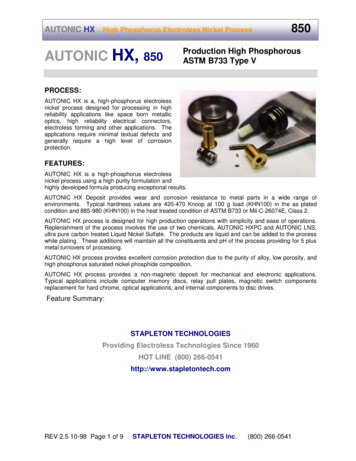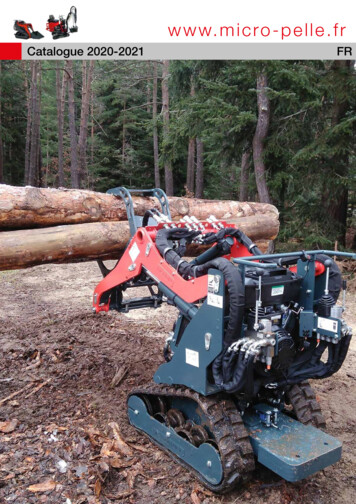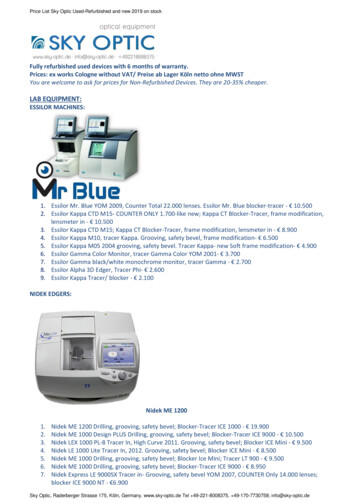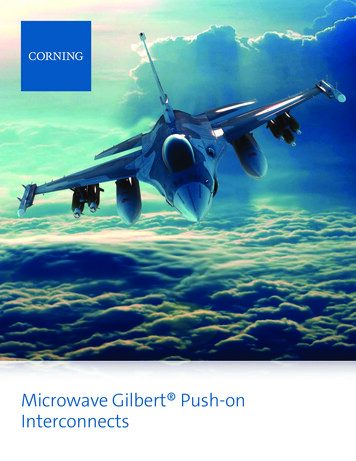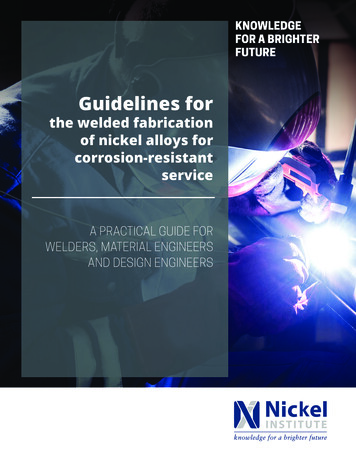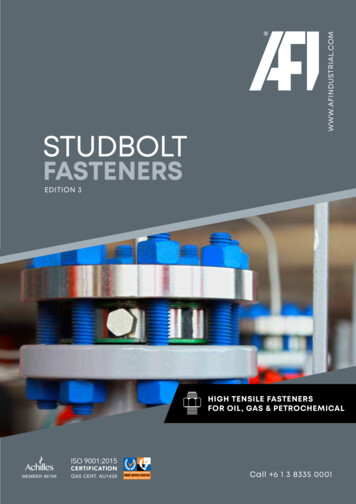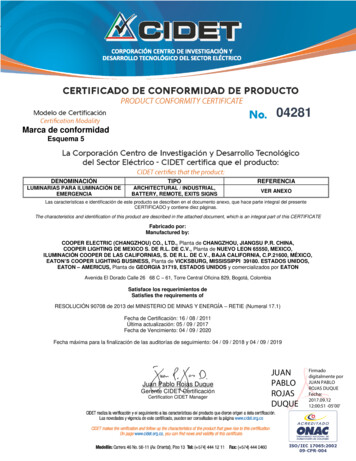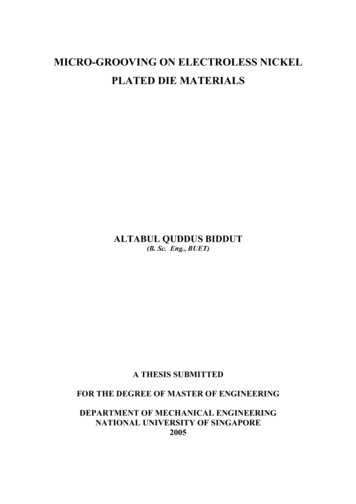
Transcription
MICRO-GROOVING ON ELECTROLESS NICKELPLATED DIE MATERIALSALTABUL QUDDUS BIDDUT(B. Sc. Eng., BUET)A THESIS SUBMITTEDFOR THE DEGREE OF MASTER OF ENGINEERINGDEPARTMENT OF MECHANICAL ENGINEERINGNATIONAL UNIVERSITY OF SINGAPORE2005
AcknowledgementsAcknowledgementsThe author would like to express his deepest and heartfelt gratitude andappreciation to Professor Mustafizur Rahman, Department of Mechanical Engineering,National University of Singapore (NUS), for his non-stop guidance, support, adviceand inspiration as academic supervisor throughout the entire research work. Hisinitiative, encouragements, patience and invaluable suggestions are gratefullyacknowledged. The author also would like to convey his sincere thanks to Assoc.Professor A. Senthil Kumar, Department of Mechanical Engineering, NUS, forproviding his invaluable assistances, encouragements and ideas during the researchwork.The author wishes to express his appreciation to Mr. Neo Ken Soon,Professional officer, AML, for his technical supports and suggestions. The author alsoextends his gratitude equally to the following staffs for their help without which thisproject would not be successfully completed; Mr. Nelson Yeo Eng Huat, Mr. TanChoon Huat, and Mr. Lim Soon Cheong from Advanced Manufacturing Lab (AML),who provided technical assistance and support in performing the experimental worksin the study.A lot of encouraging supports delivered by the author’s many friends and peersat various stages of this research work is heartily acknowledged with so much cordialthanks.Finally, the author would like to acknowledge the Mechanical EngineeringDepartment, National University of Singapore for their financial support.i
Table of ContentsTable of ContentsAcknowledgementsiTable of ContentsiiSummaryviList of FiguresviiiList of TablesxiiiList of SymbolsxivChapter 1 tion of Thesis3Chapter 2 Literature Review52.1Introduction52.2Properties of Electroless Nickel62.2.1Microstructure of Electroless Nicke62.2.2Hardness72.2.2.1Effect of Phosphorus Content72.2.2.2Effect of Heat Treatment82.2.3Corrosion Resistance92.2.3Wear Resistance9ii
Table of Contents2.3Ductile Mode Cutting of Electroless Nickel102.4Machining of Electroless Nickel with Diamond Tools132.4.1 History132.4.2Tool Wear162.4.3Scope of Work19Chapter 3 Aspects of Micromachining3.1Introduction3.2 Chip Formation202020213.3 Tool Geometry - Minimum Cutting Thickness3.4Cutting Force and Energy253.5Cutting Temperature253.6 The Action of Cutting Fluid on MachiningChapter 4 Experimental Details4.12627Experimental Set-up274.1.1Toshiba Ultra-precision Machine284.1.2Diamond Tools284.1.3Workpiece304.1.4Force Data Acquisition System314.1.5Vacuum Suction System324.1.6Chip Collection System324.2 Measuring Equipments Used4.2.1Mitutoyo Formtracer CS-50003232iii
Table of Contents4.34.44.2.2Nomarski Optical Microcope334.2.3JOEL JSM-5500 Scanning Electron Microscope &Energy Dispersive X-ray (EDX) Machine344.2.4Keyence VHX Digital Optical Microcope35Measurement and Analysis364.3.1Surface roughness Measurement364.3.2Micro-cutting Force Measurement364.3.3Tool Wear Observation374.3.4 Machined Surface Observation37Experimental Procedure374.4.1Effect of Cutting Parameters394.4.2Optimal Cutting Condition394.4.3Tool Wear Observation Procedure40Chapter 5 Results and Discussion415.1Introduction415.2Cutting Parameters425.2.142Effect of Cutting Speed435.2.1.1 Effect on Surface Roughness5.2.25.35.2.1.2 Effect on Cutting Forces45Effect of Infeed Rate475.2.2.1 Effect on Surface Roughness475.2.5.250Effect on Cutting ForcesDetermination of Optimal Cutting Conditions51iv
Table of Contents5.4 Effect of Phosphorus Content on Hardness of Wokrpieces525.5Diamond Tool Wear Characteristics535.5.1Diamond Tool Wear Patterns535.5.1.1 Diamond Tool with the 50 Rake Angle535.5.1.2 Diamond Tool with the 00 Rake Angle575.5.1.3 Diamond Tool with the- 50 Rake Angle59Diamond Tool Wear Mechanisms615.5.25.6Performance of Diamond tools655.6.1Wear Resistance and Tool Life655.6.2Cutting Forces685.6.2Machined Electroless Nickel Surface Characteristics705.7Chip ObservationChapter 6 Conclusions and Recommendations for Future Work74766.1Introduction766.2Conclusions766.3 Recommendations for Future Work78Bibliography80List of Publications86v
SummarySummaryIn recent years, ultra-precision machining with diamond turning has been rapidlygrowing for manufacturing high precision machined parts of advanced industrialapplications .Outstanding hardness and crystalline structure of diamond make itpossible to fabricate diamond cutter with very sharp cutting edges which are necessaryfor ultra-precision machining. Components with sub micron form accuracy and surfaceroughness in the nanometer range can be machined cost effectively using single pointdiamond tool due to its extreme hardness and high resistance to wear. Thus thetechnology has established itself to produce components with high degree of surfacefinish and dimensional accuracy. However, it is limited by the number of materials thatcan be produced by diamond turning, especially in the fabrication of molds for opticalcomponents. Electroless nickel is one of such machinable materials which exhibitexcellent properties such as hardness, corrosion resistance; more importantly diamondmachine electroless nickel effectively. Therefore, diamond turning of this material is aviable option for producing high quality optical surfaces without any post machiningprocess. The feature makes the technique economical and advantageous by reducingthe overall production time of machining compared to other techniques such asgrinding.Diamond turning of micro-grooves on non-ferrous metals such as electrolessnickel plated molding dies is one important application areas for the production of highprecision prismatic light guide for CD/DVD pickup lenses. Many studies had alreadybeen carried out on machining of electroless nickel as well as on other materials withdiamond tool of different crystal orientations and infrared absorption quality forvarious cutting distances. However, there is no known reported study on the evaluationof the cutting performance of the diamond tools with different rake angles duringvi
Summarymicro- grooving on electroless nickel plated die materials. The aims of this study is tocompare and investigate the cutting performance of three single crystal diamond toolswith different rake angles (00, 50 and -50) during micro grooving on electroless nickelplated die material. The machining performances are evaluated in terms of tool wear,cutting forces, and surface roughness of the machined workpieces. The wearprogression characteristics and the wear mechanisms of diamond tools with differentrake angles are presented and illustrated. The effects of machining parameters such asspindle speed and infeed rate are also investigated in this study.It was found that diamond tools with the 00 rake angle have superior performancecompared to those with 50 and -50 with respect to tool wear, cutting forces, andmachined surface roughness. Tool wears on the flank and rake faces of the 50 rakeand the -50 rake tool were found to increase with cutting distance with correspondingincrease in forces. On the other hand, the 00 rake tool machined satisfactorily up to thesame cutting distance (11.689 km) without any sign of tool wear. However, theincrease in wear on tools with 50 and -50 rake angles, and cutting forces on thediamond tools with all these three different rake angles did not significantly affect thesurface roughness. Surface quality of up to 3nm Ra was achievable during microgrooving of electroless nickel.vii
List of FiguresList of FiguresFigure 2.1Influence of Phosphorus Content and Heat TreatmentCondition on Structure7Figure 2.2Influence of Phosphorus Content on Hardness8Figure 2.3Influence of Phosphorus Content and Heat TreatmentCondition on Hardness9Figure 2.4A Chip Removal Model for Cutting Brittle Material when the 11Depth of Cut is (a) Smaller and (b) LargerFigure 2.5Influence of Phosphorus Content and Heat TreatmentCondition on Diamond Tool Wear18Figure 3.1Geometry of Orthogonal Cutting21Figure 3.2A Model of Micro Cutting22Figure 3.3Cutting Force in the Elastic Region22Figure 3.4Force Model in Cutting Region23Figure 3.5Stress on the Neutral Point24Figure 4.1Photographic View of Experimental Setup27Figure 4.2View of the Toshiba ULG-100C Ultra-precision Machine28Figure 4.3(a)Single Point Diamond Tool (00 rake)29Figure 4.3(b)Single Point Diamond Tool ( 50 rake)29Figure 4.3(c)Single Point Diamond Tool (-50 rake)29Figure 4.4Electroless Nickel Plated Workpiece30Figure 4.5Schematic View of the Machined Workpiece and Details ofGroove X- Section31Figure 4.6Schematic Diagram of Micro-cutting Force Data AcquisitionSystem32Figure 4.7Photographic View of Mitutoyo FORTRACER33Figure 4.8Nomarski Optical Microscope (Olympus STM-6)34viii
List of FiguresFigure 4.9Scanning Electron Microscope (SEM) Associated with EnergyDispersive X-ray (EDX) Machine35Figure 4.10Photograph of Keyence VHX Digital Optical Microscope36Figure 5.1Cutting Force Directions on Tool43Figure 5.2Variation of Surface Roughness with Spindle Speed forDifferent Tools with Different Rake Angles44Figure 5.3(a)Photograph of the Machined Surface and Corresponding RProfile at 100 rpm with 00 Rake Tool44Figure 5.3(b)Photograph of the Machined Surface and Corresponding RProfile at 250 rpm with 0o Rake Tool44Figure 5.3(c)Photograph of the Machined Surface and Corresponding RProfile at 500 rpm with 00 Rake Tool45Figure 5.3(d)Photograph of the Machined surface and Corresponding RProfile at 750 rpm with -50 Rake Tool45Figure 5.3(e)Photograph of the Machined Surface and Corresponding RProfile at 1000 rpm with 00 Rake Tool45Figure 5.4(a)Effect of Spindle Speeds on Cutting Forces for the Tools withThree Different Rake Angles46Figure 5.4(b)Effect of Spindle Speeds on Thrust Forces for the Tools withThree Different Rake Angles47Figure 5.5Variation of Surface Roughness with Infeed Rate for DifferentTools with Different Rake Angles48Figure 5.6(a)Photograph of The Machined Surface and Corresponding RProfile at 0.1µm/rev with 0 deg. Rake Tool.48Figure 5.6(b)Photograph of the Machined Surface and Corresponding RProfile at 0.5µm/rev with 0 deg. Rake Tool49Figure 5.6(c)Photograph of the Machined Surface and Corresponding RProfile at 1µm/rev with -5 deg. Rake Tool.49Figure 5.6(d)Photograph of the Machined Surface and Corresponding RProfile at 2 µm/rev with 5 deg. Rake Tool.Figure 5.6(e)Photograph of the Machined Surface and Corresponding RProfile at 3 µm/rev with 0 deg. Rake Tool4950ix
List of FiguresFigure 5.7(a)Effect of Infeed Rates on Cutting Forces for the Tools withThree Different Rake Angles50Figure 5.7(b)Effect of Infeed Rates on Thrust Forces for the Tools withThree Different Rake Angles51Figure 5.8Effect of Phosphorus Content on Hardness of Workpieces52Figure 5.9(a)Nomarski Microscope Photograph of Flank Wear Region ofDiamond Tool with 50 Rake Angle after Cutting 2.347 km54Figure 5.9(b)Nomarski Microscope Photograph of Flank Wear Region ofDiamond Tool with 50 Rake Angle after Cutting 6.03 km54Nomarski Microscope Photograph of Flank Wear Region ofDiamond Tool with 50 Rake Angle after Cutting 7.26 km54Figure 5.9(d)SEM Photograph of Micro-grooves on Flank Wear Region ofDiamond Tool with 50 Rake Angle after Cutting 7.26 km55Figure 5.9(e)SEM Photograph of Flank Wear Region of Diamond Tool with 55 50 Rake Angle after Cutting 10.5 kmFigure 5.9(f)SEM Photograph of Micro-grooves on Flank Wear Region ofDiamond Tool with 50 Rake Angle after Cutting 10.5 km55Figure 5.10(a)Nomarski Microscope Photograph of Rake Face of DiamondTool with 50 Rake Angle after Cutting 4.9 km56Figure 5.10(b)SEM Photograph of Rake Face of Diamond Tool with 50Rake Angle after Cutting 8.5 km56Figure 5.10(c)SEM Photograph of Rake Face of Diamond Tool with 50Rake Angle after Cutting 10.5 km57Figure 5.11(a)VHX digital Microscope Photograph of Flank Face ofDiamond Tool with 00 Rake Angle after Cutting 7.53 km57Figure 5.11(b)VHX digital Microscope Photograph of Flank Face ofDiamond Tool with 00 Rake Angle after Cutting 11.69 km58Figure 5.12(a)VHX digital Microscope Photograph of Rake Face ofDiamond Tool with 00 Rake Angle after cutting 7.53km58Figure 5.12(b)VHX digital Microscope Photograph of Rake Face ofDiamond Tool with 00 Rake Angle after Cutting 11.69 km58Figure 5.13(a)VHX Digital Microscope Photograph of Flank Face ofDiamond Tool with -50 Rake Angle after Cutting 3.76 km59Figure 5.9(c)x
List of FiguresFigure 5.13(b)VHX Digital Microscope Photograph of Flank Face ofDiamond Tool with -50 Rake Angle after Cutting 9.42 km60Figure 5.14(a)VHX Digital Microscope Photograph of Rake Face ofDiamond Tool with -50 Rake Angle after Cutting 1.88 km60Figure 5.14(b)VHX Digital Microscope Photograph of Rake Face ofDiamond Tool with -50 Rake Angle after Cutting 5.65 km60Figure 5.14(c)VHX Digital Microscope Photograph of Rake Face ofDiamond Tool with -50 Rake Angle after Cutting 9.42 km61Figure 5.14(d)VHX Digital Microscope Photograph of Rake Face ofDiamond Tool with -50 Rake Angle after Cutting 9.42 km61Figure 5.15Schematic Diagram of Chip Flow Mechanism63Figure 5.16(a)Keyence VHX Optical Microscope Photography of Flank Faceof -50 Rake Angle tool with Adhered Layer of ElectrolessNickel.64Figure 5.16(b)Keyence VHX Optical Microscope Photography of Flank Faceof 00 Rake Angle tool with Adhered Layer of ElectrolessNickel.64Figure 5.17EDX (Energy Dispersive X-ray) Analysis of the AdheredLayer on the -50 Rake Angle Tool.64Figure 5.18Flank Wear with Cutting Distance for the Tools with DifferentRake Angles66Figure 5.19(a)Rake Face of the -50 Rake Angle Tool after Cutting 11.69km67Figure 5.19(b)Rake Face of the 50 Rake Angle Tool after Cutting 11.69km67Figure 5.20(a)Effect of Cutting Distance on Thrust Forces for DiamondTools with Different Rake Angles69Figure 5.20(b)Effect of Cutting Distance on Cutting Forces for DiamondTools with Different Rake Angles70Figure 5.21(a)Effect of Cutting Distance on Surface Roughness, Ra71Figure 5.21(b)Effect of Cutting Distance on Surface Roughness, Ry71Figure 5.22(a)Roughness Profile of Electroless Nickel for tool with the 00rake angle after cutting 11.69km72Figure 5.22(b)Roughness Profile of Electroless Nickel for tool with the -50rake angle after cutting 11.69km.72xi
List of FiguresFigure 5.22(c)Roughness Profile of Electroless Nickel for tool with the 50rake angle after cutting 11.69km.Figure 5.23(a)Photograph of Machined Micro-grooves after cutting 11.69 km 73with the 00 rake angleFigure 5.23(b)Photograph of Machined Micro-grooves after cutting 11.69 km 74with the -50 rake angleFigure 5.23(c)Photograph of Machined Micro-grooves after cutting 11.69 km 74with the 50 rake angleFigure 5.24(a)Machined Electroless Nickel Chip Produced by 00 Rake AngleTool75Figure 5.24(b)Machined Electroless Nickel Chip Produced by -50 RakeAngle Tool75Figure 5.24(c)Machined Electroless Nickel Chip Produced by 50 RakeAngle Tool7573xii
List of TablesList of TablesTable 4.1The Geometries of Diamond Tools29Table 4.2Matrix of Cutting Parameter39Table 4.3Cutting Conditions during Performance Test40xiii
List of SymbolsList of SymbolsBcMinimum cutting thicknessFcCutting forceFtThrust forceLcTool chip contact lengthfFeed ratepeNormal stress on the round tool edge in elastic regionrThe tool edge radiustmMinimum cutting thicknesst1Uncut chip thicknesst2Chip thicknesswWidth of the toolαTool rake angleαeEffective tool rake angleϕShear angleβMean friction angle between the chip and the toolµFriction coefficientβeFriction angle in elastic regionβpFriction angle in plastic regionτSShear strengthγClearance anglexiv
Chapter 1: IntroductionChapter 1Introduction1.1OverviewUltra precision metal cutting is one of the most successful developments withinlast fifty years. Generally, this can be defined as a cutting technique which enables usto produce components with micrometer or sub micrometer form accuracy and surfaceroughness within a few tens nanometer. From 1960’s, its development started as apromising method for fabricating dedicated optical, mechanical, or electronic partsessential for different particular advanced applications. The technique was applied forthe production of a variety of optical components through the 1970’s for its highprecision, versatility and lower overall manufacturing cost. In the 1980’s the techniquehas resulted in extended industrial use for manufacturing of aluminum scanner mirrors,and aluminum substrates for computer memory disks; where very fine surface finishwas highly desirable. Along with these industrial applications, more recently thetechnique has been also used for the manufacturing of highly sophisticated opticalparts with extremely high geometrical accuracy and surface finish [Ikawa et al., 1991].By Continuous improvement, not only of machine parts (spindles, slides etc.)machine constructions, electronic control, measuring techniques, but also of cuttingtool quality are now common practice [Oomen and Eisses, 1992].Outstanding hardnessand crystalline structure of diamond holds the possibilities to fabricate diamond toolswith very sharp cutting edges which are necessary for ultra precision machining.Components with sub micron form accuracy and surface roughness in the nanometerrange can be machined cost effectively using single point diamond tools due to theirMicro-grooving on Elcetroless Nickel Plated Die Materials1
Chapter 1: Introductionextreme hardness, high resistance to wear, and good thermal conductivity for heatremoval during machining [Rahman et al., 2004].Technology has established itself already to produce components with highdegree of surface finish and dimensional accuracy. However, it is limited by thenumber of materials that can be produced by diamond turning, especially in thefabrication of molds for optical components. Electroless nickel is one of such materialswhich exhibit excellent properties such as hardness, corrosion resistance; moreimportantly diamond machines electroless nickel very efficiently. Therefore, thediamond turning of this material becomes a viable option for producing high qualityoptical surfaces without any post machining process. The feature makes the techniqueeconomical and advantageous by reducing the overall production time of machiningcompared to other techniques such as grinding and lapping [Casstevens, 1978].The studies were already carried out for turning of electroless nickel as well asother materials with diamond tools of different crystal orientations and infraredabsorption quality for various cutting distance. However, machining performance ofdiamond tools with different rake angles is not well investigated. Besides, microgrooving on electroless nickel plated die materials with diamond tools are alsoessential to study for its increasing applications for producing very high resolution andhighly accurate prismatic light guide for CD/ DVD pickup lenses. The example ofunique capability of micro-grooving on an electroplated copper disk with diamondtools is done already for mastering of new optical memory disk application.[Ikawa,1991]. Therefore, this study has attempted to machine micro-grooves with diamondtools with different rake angles on electroless nickel plated die materials. The aims ofresearch work are to compare and investigate the performance of three single pointdiamond tools with different rake angles (00, 50 and -50). The machining performanceMicro-grooving on Elcetroless Nickel Plated Die Materials2
Chapter 1: Introductionwas evaluated in terms of tool wear, cutting forces and surface roughness of themachined workpieces. The characteristics of wear pattern of the tools and it’smechanisms with different rake angles are carried out. Moreover, effects of machiningparameters, infeed rate and cutting speed, are also carried out to find a suitable opticalcutting condition within this study.1.2ObjectivesThe objectives of this study are described below. To investigate the effects of different machining parameters of single crystaldiamond tools with three different rake angles during micro grooving onelectroless nickel-plated materials. To investigate wear patterns and wear mechanisms of diamond tools withrespect to cutting distance for diamond tools with three different rake angles. To investigate the machining performance of diamond tools with three differentrake angles with respect to tool wear, machined surface roughness, and microcutting forces. To investigate the machined electroless nickel surface and the chips producedwhile cutting with diamond tools with three different rake angles.1.3Organization of ThesisIn Chapter 2, the brief history of electroless nickel deposits and it’s machining withdiamond tool are discussed. Investigations on theoretical aspect of micro-grooving onbrittle materials and factors affecting the technique are discussed in Chapter 3. Chapter4 describes the experimental setup and procedure, the details about workpieces, cuttingtools, machining parameters, surface measurement system, cutting forces dataMicro-grooving on Elcetroless Nickel Plated Die Materials3
Chapter 1: Introductionacquisition system and taking pictures of surfaces and cutting edges. Detailsdiscussions of the experimental findings are presented in Chapter 5. The conclusionsdrawn from this study are presented in Chapter 6, along with a brief discussion on thefuture directions of the work.Micro-grooving on Elcetroless Nickel Plated Die Materials4
Chapter 2: Literature ReviewChapter 2Literature Review2.1IntroductionElectroless nickel coatings have been used increasingly in various industriessince the early 1980’s. Some of the outstanding characteristics of these coatings areexcellent corrosion and wear resistance, exceptional uniformity, wide range ofthickness as well as mechanical and physical properties, good solderability, andsurface lubricity [Baudrand, 1978]. They are widely used either as protective ordecorative coatings in many industries, including optics, electronics, computer,nuclear, chemical, petroleum, and aerospace [Parker, 1972]. In addition, compared toconventional electroplating methods, elcetroless nickel coatings can be applied ondifferent substrates, either conductive or nonconductive, since no external current isapplied to the component. The process is termed “autocatalytic” where nickel acts ascatalyst in the reaction [Casstevens and Daugherty, 1978].Although electroless nickel coatings are fairly new, the discovery of the factthat nickel could be deposited on a surface from an aqueous solution of its salt byreduction with hypophosphite was proposed by Waltz in 1844 [Reidel, 1991]. Due tothe poor quality of the reducing agents that leads to rough deposits with inferiorproperties, Waltz’s idea was not developed for a whole century. In 1944, the firstlaboratory experiment reported on electroless nickel was completed by Brenner andRiddel, who were later given credit for introducing the electroless nickel method to theworld. The process discovered was patented in 1950. The process was furtherdeveloped by General American Transportation Corporation and marketed under name“Kanigen” [Casstevens and Daugherty, 1978]. The years 1978 to 1982 marked aMicro-grooving on Elcetroless Nickel Plated Die Materials5
Chapter 2: Literature Reviewfurther advance in the technology, insofar as phosphorous-rich electroless nickelcoatings were developed. These deposits are normally laid down without the use ofheavy metal or sulphur-coating stabilizers and form a glassy, amorphous structure.Where problems due to corrosion or wear arise, such electroless nickel coatingsknown as “third-generation”- are finding increasing applications [Reidel, 1991].Nowadays, electroless nickel is no longer a single type of coating but an entirefamily of coatings. Thus, they are available from many companies for commercial andexperimental use. However, electroless nickel with high phosphorus content ( 13%) isdifficult to achieve and more importantly, costly. In addition, the other problem is toget high thickness of coating which results in defective surface [Pramanik, 2004].2.2Properties of Electroless Nickel2.2.1Microstructure of Electroless NickelThe properties of electroless nickel coatings are directly attributed to theirmicro structural characteristics. The phosphorus content of electroless nickel depositscontrols their microstructure and properties [Park and Lee, 1988]. Electroless nickeldeposit is not well understood in their details structure but as plated electroless nickelcoatings have been reported to be either crystalline, amorphous, or a co-existence ofboth. The general trend in the understanding of electroless nickel deposits is that asplated electroless coatings containing 1-5% phosphorus are crystalline; thosecontaining 6-9% phosphorus consist of mixed crystalline and amorphousmicrostructures; whereas those containing 10-13% phosphorus are amorphous andcrystallize on heat treatment to nickel and various forms of nickel phosphides.However, since the diffraction pattern of the high-alloy electroless nickel deposits arevery similar to those of materials that are rapidly cooled from the liquid state and thatMicro-grooving on Elcetroless Nickel Plated Die Materials6
Chapter 2: Literature Revieware considered to be glasses, electroless nickel can justifiably be considered amorphous[Mallory and Haju, 1990]. Figure 2.1 shows the structure of as-plated electrolessnickel coatings with variation of phosphorus content and heat treatment temperatures.Figure 2.1: Influence of Phosphorus Content and Heat Treatment Condition onStructure [Syn and Dini, 1985]2.2.2HardnessHuge amount of works regarding the hardness of electroless nickel were doneand therefore, hardness is the most widely studied property of electroless nickeldeposits [Riedel, 1991]. Hardness, which plays a significantly important role inselecting the cutting tool materials and values of cutting parameters, is mainlycontrolled by the phosphorus content and heat treatment, this fact makes elcetrolessnickel more attractive in machining world.2.2.2.1Effect of Phosphorus ContentThe hardness of electroless nickel deposits, as with other properties, is directlyaffected by the phosphorus content. As Figure 2.2 shows, increasing the phosphoruscontent of the deposits lowers the hardness of the coating. At the maximum hardnessthe phosphorus content is minimum where the microstructure consists of singleMicro-grooving on Elcetroless Nickel Plated Die Materials7
Chapter 2: Literature Reviewcrystallize β phase. As the phosphorus content increase, β phase in microstructuredecreases while amorphous γ phase increases; which leads to reduce the hardness ofthe elcetroless nickel coating as the γ phase is a softer compared to the β phase. Theminimum value of hardness is reached when the amount of phosphorus content is high(11%P) with completely γ phase in microstructure [Duncan, 1983].Figure 2.2: Influence of Phosphorus Content on Hardness [Duncan, 1983].2.2.2.2Effect of Heat TreatmentOne of the outstanding characteristics of electroless nickel coatings is thepossibility of obtaining very high hardness values through an appropriate heattreatment process, thus post heat treatment process is a significant impact on thehardness of electroless nickel coatings. Heat treatment of electroless nickel depositsprovides a unique wear and erosion resistance. Figure 2.3 shows the effect of heattreatment temperature on electroless nickel coatings hardness. The maximum hardnesswas obtained after a heat treatment at 400oC for one hour whish is also reported frommany other studies [Baudrand, 1978 and Reidel, 1997].Micro-grooving on Elcetroless Nickel Plated Die Materials8
Chapter 2: Literature ReviewFigure 2.3: Influences of Phosphorus Content and Heat Treatment Conditionon Hardness [Syn et al., 1985]2.2.3Corrosion ResistanceExcellent corrosion resistance is another unique property of electroless nickelcoatings in different industrial environments. This corrosion resistance is attributed bytheir phosphorus content. However, the concept that high phosphorus coatings aremore corrosion resistant than low phosphorus coatings cannot be generalized for allindustrial environments. However, coatings having high phosphorus content haveamorphous microstructures, which provides a better corrosion resistance due to theabsence of grain boundaries. There are several other factors affecting the corrosionproperties of electroless nickel coatings which include coating thickness, porosity, typeof heat treatment [Duncan, 1983].2.2.4Wear ResistanceOne of the unique characteristics of electroless nickel deposition is the superiorwear resistance of the coatings. The wear resistance of electroless nickel depositsdepends on both phosphorus content and the type of post heat treatment applied.However, there are numerous parameters such as the nature of the applied stress whichaffect wear properties. It was explained previously that the hardness reaches its highestMicro-grooving on Elcetroless Nickel Plated Die Materials9
Chapter 2: Literature Reviewvalue at approximately 4 % phosphorus content - the γ phase first forms- whereas itreaches its lowest value when the last remaining β phase disappears. The sameconclusion is true for explaining the wear resistance properties of electroless nickelcoatings.2.3Ductile Mode Cutting of Electroless NickelAs described in the previous sections, electroless nickel, having manyadvanced physical and mechanical properties, is now used extensively in opticalindustry and infra-red optics. Microscopically, electroless nickel is considered to be anextremely brittle and hard material that exhibits little ductility during actual machining.Therefore, in order to generate surfaces of high optical quality on brittle materials such
4.2.3 JOEL JSM-5500 Scanning Electron Microscope & Energy Dispersive X-ray (EDX) Machine 34 4.2.4 Keyence VHX Digital Optical Microcope 35 4.3 Measurement and Analysis 36 4.3.1 Surface roughness Measurement 36 4.3.2 Micro-cutting Force Measurement 36 4.3.3 Tool Wear Observation 37 4.3.4 Machined Surface Observation 37
